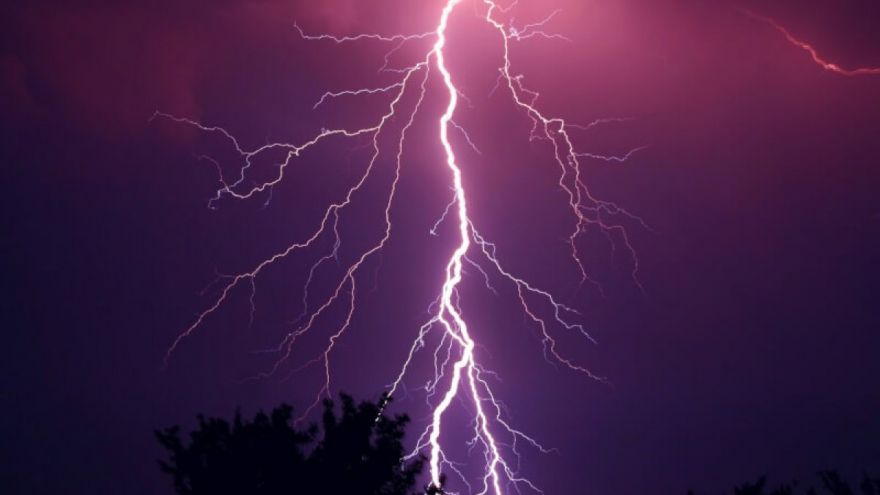What to Do if You Get Caught in a Lightning Storm in the Backcountry
 What to Do if You Get Caught in a Lightning Storm in the Backcountry
gearweare.net
What to Do if You Get Caught in a Lightning Storm in the Backcountry
gearweare.net
A lightning strike occurs when an electrically charged current coming out of a thunderhead makes contact with an electrical current coming from an object on the ground. The grounded currents, called streamers, are pulled into the sky in the presence of an electrical storm. For the connection to occur, a streamer must be in close proximity to the current coming from the cloud, called the stepped leader. Objects that are higher, and consequently closer to the cloud, are therefore the most likely to be hit by lightning. The area directly under a cloud is also much more likely to receive strikes.
Where lightning meets the ground is quite random. Bolts sometimes move horizontally along the base of a cloud and can strike as far as 10 miles from where they originated. So, despite the unlikelihood of a lightning strike hitting you at the base of a mountain or while the skies overhead remain blue, if you can hear thunder there it is possible for you to get hit.
If you get stuck outside during a lightning storm, protecting yourself completely is impossible. However, there are things you can do to lower your odds of being struck.
Table of Contents
Plan Ahead and Keep an Eye on the Skis
The arrival of a thunderstorm should never be a surprise. When planning a trip into the backcountry, whether for a day hike or multi-day backpacking trip, you should make sure to have a clear understanding of the weather patterns you may encounter. Make sure to check the weather in every area you will be passing through. The topography of mountains catches and pushes storms, so a few miles in one direction or another may mean the difference between sunshine and rain. The best way to get a clear idea of what the weather may be is to look at the current radar right before you set out. It is also important to plan your trip with storms in mind. For example, here in Colorado summertime means thunderstorms almost every afternoon, so when we plan day hikes we leave early, summit by 11am or 12pm, and aim to be back at the car no later than 3pm.
As you hike, continue to keep your eyes and ears peeled for any signs of a storm. If a storm begins to move in, turn around or seek shelter immediately.
Seek Shelter
The only way to truly protect yourself in a thunderstorm is to go inside a building. If you can’t get to a building, a car is second best. The odds in either of these structures are so reduced that, unless the danger is so immediate that you can’t move, it is better to walk a mile through a storm to safety than to wait it out in the woods or your tent.
In fact, staying in your tent offers no extra protection from lightning, and in some cases, can even increase your chances of getting hit. Metal is conductive, so metal poles may draw a bolt toward you. More dangerous is if your tent is in an open field where it is the tallest object. In this case, do not stay inside the tent. If your tent is near trees, staying inside to protect yourself from rain is no more dangerous than being outside under the same trees, but do not forget that a strike is still possible.
Some people believe that they will be protected from a lightning storm under a pavilion. However, everything just stated about tents applies to these structures as well, especially if they are made of stone.
Get to Safer Ground
If going inside a building or car is not an option, there are some places in the landscape you can go that are safer than others. As mentioned earlier, lightning is more inclined to strike the highest point. If you are above tree line this issue is compounded by the fact that mountaintops see more strikes and that you may be the tallest object in the landscape. Move downhill as quickly as possible. Aim for a valley and look for depressions in the earth. The goal is to situate yourself as low within the landscape as you possibly can.
Stay away from fields or open landscapes, even if you aren’t at a high elevation. For a taller object to reduce your chances of getting hit, it must be within 50 meters of where you are standing. This does not apply to trees because when struck, the base of a tree will often send out surface arcs. Being struck by one of these can cause significant harm. Avoid going near the tallest tree in an area. Caves should also be avoided. Metal and rock conduct electricity, so standing in a cave, especially near the entrance, can increase your chances of getting struck.
One common myth is that water in earth makes a location more likely to be hit. In fact, water logged ground moves currents away from a location more quickly, and is just as safe to sand on as dry ground. However, standing in water is incredibly dangerous and should be avoided at all costs.
Assume the Lightning Position
If there is no way that you can escape a storm, assuming the lightning position can help you reduce your chances of getting hit. There is also anecdotal evidence that those hit by lightning while in this position suffer fewer injuries, and no one struck while in the lightning position has died.
To take the lightning position place your feet together, and squat down as low as you can. Hug your knees and rest your head on top of your legs to make it more comfortable and easier to hold for a long period of time.
If possible, stand on your backpack, sleeping pad, or anything else you may have with you. This helps to ground you to the earth. Do not stand on a backpack if it has a metal frame. Remove all metal from your person, including jewelry and zippers. If a lightning strike seems imminent, have everyone in your group move apart by 50 meters before taking the lightning position. This helps to reduce the likelihood of multiple injuries.











